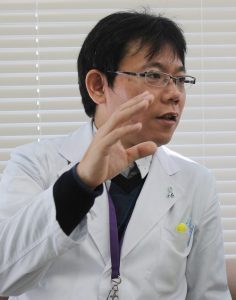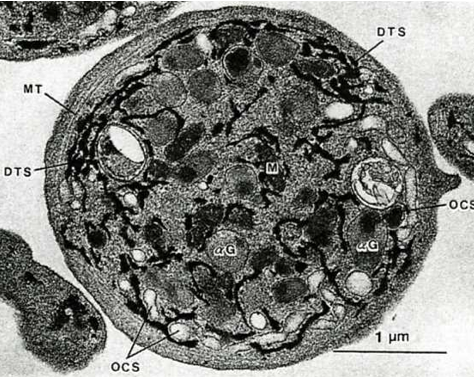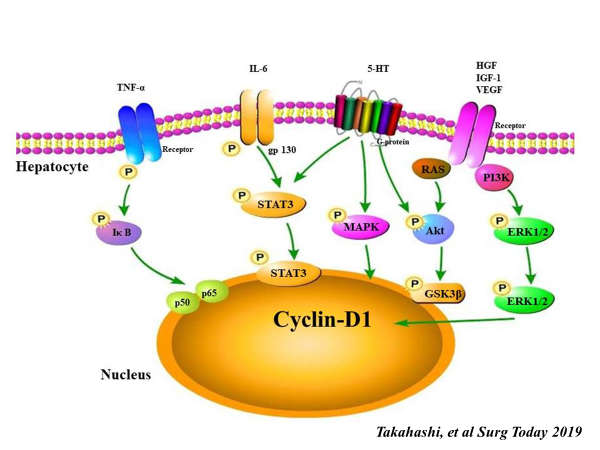キーワード: 肝再生、肝硬変、血小板、TPO、劇症肝炎
http://www.md.tsukuba.ac.jp/clinical-med/ge-surg/index.html

血小板は生理活性物質であるサイトカインや成長因子が含まれる袋のようなものです。移植時の肝臓では、血小板が内包するサイトカインが放出された後に肝炎が起きることから、血小板は肝臓の障害を悪化させるという報告が多く寄せられていました。
血小板による新規肝疾患治療法開発・リサーチユニットは、すでに明らかになっている肝臓の再生促進や繊維化の予防の研究成果を元に、「肝臓の移植における血小板の働き」にテーマを絞り、研究を進めています。血小板が、移植手術後の肝炎を抑制する作用を証明し、メカニズムを解析することで治療に役立てることが研究の主要な目的です。
肝臓の移植における血小板の役割を調べる

図1:肝再生する血小板について(日本医科大学 鈴木英紀先生よりご提供)
肝移植では移植した肝臓に血液を再灌流させるために、血小板が生理活性物質であるサイトカインを放出することで肝障害(虚血再灌流障害)を引き起こしているように見えます。しかし、炎症は治癒過程の一つなので、血小板がむしろ血液再灌流における肝障害を抑制しているのではないかとも考えることができます。
血小板には増殖因子や生理活性物質が多く含まれ、臨床で濃厚血小板血漿(platelet rich plasma,PRP)を用いた再生治療がすでに行われています。私たちの研究でも、血小板が肝切除直後に肝臓に集積し,一部の血小板が肝細胞と直接接触することが電子顕微鏡と生体顕微鏡にて確認されたことから,血小板に含まれる成長因子である幹細胞増殖因子(HGF)、インシュリン様増殖因子(IGF-1)が肝細胞に直接作用して DNA合成を促進すると考えています。
上記のように血小板が肝臓の再生を促進することは通常の肝切除では証明されていますが、肝移植後の血液の再灌が起きているときの肝再生や肝傷害については専門家の間でも未だ意見が分かれているため、血小板による移植時の移植肝再生や肝傷害のメカニズムを証明することが目下の研究課題です。
レシピエントの術後の早い回復とドナーの増加で、救える命の数を増やす

図2:血小板による肝炎抑制のメカニズム
血小板の数値の低い患者に対して肝移植を行うと、術後の立ち上がりが悪いという臨床のデータが出ているため、血小板を増やせば術後の立ち上がりが良くなるのではないかという仮説を立て、血小板の移植時の肝再生促進作用や肝傷害抑制作用のメカニズムの解明に取り組んでいます。
私たちはラットを使い、肝臓全体の30%を移植する部分肝移植の実験を行いました。肝移植を行う約1週間前に、トロンボポエチン製剤を用いて血液中の血小板の値を上昇させたラットと、血小板の値が正常値のラットで、移植肝の肝再生を比較した結果、血小板を増やしたラットでは、TNF-alfaやIL-6などの肝再生を促進するサイトカインが高く、移植肝の再生も促進していることが分かりました。
一方で、血小板の高いラットでは虚血再灌流性障害を示す酵素やサイトカインの値が低い傾向を示すことも明らかにしました。特別な蛍光顕微鏡で見ると、血小板は移植肝に次々に集まることを確認でき、さらに肝臓に住み着いているKupffer細胞という細胞が、この血小板を集積させる作用があることも証明しました。Kupffer細胞は肝障害を起こす細胞でもありますが、集積した血小板から放出する成長因子がKupffer細胞の肝障害を抑制しているのではないかと考えています。
私たちの研究で血小板の移植時における肝再生促進作用や肝傷害抑制作用が明らかになれば、脂肪肝で肝臓の部分提供が難しい方や、レシピエントと体のサイズに違いがあり、小さい部分肝しか提供できない方でもドナーになることができ、術前に血小板を増やすことができればより安全に肝切除・移植できる可能性も高まるでしょう。私たちの研究は、今後発展してくる移植再生医療に合わせ、より安全に肝切除や肝移植を行い、より多くの人命を救える可能性を秘めていると考えています。
社会への貢献・実績
-
血小板による新規肝疾患治療法開発
-
『血小板による肝移植後のグラフト生着率の向上とその機序についての組織的な解明』論文発表(2017~2018年)
-
『血小板の部分肝移植術後のグラフト生着率向上に関する探索的研究』論文発表(2017~2018年)
-
移植医療に対する、世界的視野を持つ人材育成
取材日:2020年2月6日
Demonstrating the positive role of platelets in liver transplantation
Other agencies : Tateno Hiroaki
Unit name: New therapy for liver diseases by platelets
Keywords: Liver regeneration, Liver cirrhosis, Platelets, TPO, Fulminant hepatitis
http://www.md.tsukuba.ac.jp/clinical-med/ge-surg/index.html

Platelets are something like bags containing physiological active substances, cytokines and growth factors. It has been frequently reported that platelets aggravate hepatic damage in transplantation because hepatitis occurs after cytokines enclosed in platelets are released.
The research unit, New therapy for liver diseases by platelets, is advancing research focusing on ‘platelet action in liver transplantation’ based on already clarified results of studies on the promotion of liver regeneration and prevention of fibrosis. The main objective of the research is to demonstrate the platelet action inhibiting hepatitis after transplant operations and analyze the mechanism to make use of it for treatment.
Investigation of the role of platelets in liver transplantation

Fig. 1:Platelets regenerating the liver (provided by Dr. Hideki Suzuki, Nippon Medical School)
In liver transplantation, platelets appear to induce liver disorder (ischemia-reperfusion injury) by releasing physiological active substances, cytokines, to re-perfuse the transplanted liver, but it can be considered that platelets rather inhibit reperfusion-induced liver disorder because inflammation is a healing process.
Platelets contain many growth factors and physiological active substances, and regenerative treatment using platelet rich plasma (PRP) is already performed in clinical practice. Our study also confirmed by electron microscopy and biomicroscopy that platelets accumulate in the liver immediately after hepatectomy and a part of platelets directly contact hepatocytes, suggesting that stem cell growth factor (HGF) and insulin-like growth factor (IGF-1) contained in platelets directly act on hepatocytes and promote DNA synthesis.
It has been demonstrated that platelets promote liver regeneration in normal hepatectomy, as described above, but there is still controversy about liver regeneration and liver injury during reperfusion after liver transplantation among experts and demonstration of the mechanisms of platelet-induced regeneration of transplanted liver and liver injury in transplantation is an important research subject at present.
Increasing the number of lives that can be saved through the early recovery of recipients after surgery and an increase in donors

Fig. 2: Mechanism of hepatitis inhibition by platelets
Since clinical data showing inferior postoperative rising after liver transplantation have been acquired in patients with a low platelet count, hypothesizing that postoperative rising is improved by increasing platelets, we have been coping with elucidation of the mechanisms of the liver regeneration-promoting and liver injury-inhibiting actions of platelets in transplantation.
We performed a partial liver transplantation experiment using rats in which 30% of the whole liver was transplanted. Rats with a blood platelet count elevated using thrombopoietin preparation about 1 week before liver transplantation and rats with a normal platelet count were prepared and the regeneration of the transplanted liver was compared. In the rats with increased platelets, the levels of liver regeneration-promoting cytokines, such as TNF-alfa and IL-6, were high, showing that regeneration of the transplanted liver was promoted.
On the other hand, the levels of enzymes causing ischemia-reperfusion injury and cytokines tended to be low in the rats with a high platelet count. When observed under a special fluorescence microscope, platelets gathered in the transplanted liver one after another and it was also demonstrated that Kupffer cells inhabiting the liver have this platelet-accumulating action. Kupffer cells cause liver disorder, but we consider that growth factors released by accumulated platelets inhibit Kupffer cell-induced liver disorder.
If our study clarifies the liver regeneration-promoting and liver injury-inhibiting actions of platelets in transplantation, persons with difficulty in donating a part of their liver due to fatty liver and persons who can donate only a small part of the liver due to a difference in the body size from that of the recipient can become donors and if platelets can be increased before surgery, the possibility of safer hepatectomy/transplantation may increase. Our study may have the potential to save more lives by safer hepatectomy/transplantation corresponding to transplantation and regenerative medicine which will develop in the future.
Social contributions and achievements
-
Development of a novel liver disease treatment method using platelets
-
Paper publication: ‘Improvement of the rate of platelet-induced engraftment after liver transplantation and systematic elucidation of its mechanism’ (2017-2018)
-
Paper publication: ‘Exploratory research on improvement of the rate of platelet-induced engraftment after partial liver transplantation’ (2017-2018)
-
Development of human resources having global perspective of transplant medicine
Interviewed on Feb., 6, 2020
